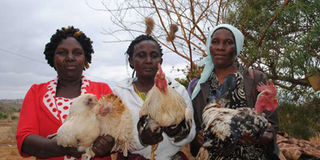How I tell whether my eggs will hatch into male or female chicks

Christine Kilonzi (left) and fellow farmers with birds they keep. Kilonzi, the owner of the birds, is seated on a wooden bench, and before her is a crate of eggs.The poultry farmer picks two eggs at a time, keenly examining them before marking on each F and M with a marker. She then puts them in a separate tray and picks another set. PHOTO | LEOPOLD OBI
What you need to know:
- With the help of Prolinova, a non-profit organisation that deals with smallholder farmers, Kilonzi has received support to popularise her skill that won her an award in the East African Farmers Innovation Fair in 2013, which attracted contestants from five countries.
- Other methods mainly used by hatcheries but after the eggs have hatched, according to Dr Kamau, is for instance, looking at the formation of the birds’ wings.
- The expert, however, notes that the wing method is useful within three days of a chick’s life, beyond which other methods such as comb shape and size and also shape of the vent can be applied.
In the small compound in Mwingi, Kitui County, tens of birds roam freely.
Some lie on the ground while others rummage for worms from the soil.
Christine Kilonzi, the owner of the birds, is seated on a wooden bench, and before her is a crate of eggs.
The poultry farmer picks two eggs at a time, keenly examining them before marking on each F and M with a marker. She then puts them in a separate tray and picks another set.
The farmer, who lives in Ithumbi village, boasts of a unique skill that enables her to tell whether an egg would hatch a male or female chick by simply looking at its shape.
“The M mark means an egg will hatch into a male chick while F will hatch into a female one,” explains Christine, who rears about 100 birds under the free-range system.
By making the marks on the eggs, she is able to estimate the number of hens and cockerels she would have in her brood.
According to her, eggs that have a pointed end hatch into female chicks and those with rounded ones produce male chicks.
The rare skill has earned Kilonzi accolades and clients, with the concept being researched on by Kenya Agricultural and Livestock Research Organisation.
“Many times clients make very specific requests. One would, for instance, ask for hens only, thus, this skill comes in handy,” she explains, adding that poultry is the most vibrant venture in the area as crop farming does not perform well due to shortage of rain.
SHARP-POINTED EGGS
With the help of Prolinova, a non-profit organisation that deals with smallholder farmers, Kilonzi has received support to popularise her skill that won her an award in the East African Farmers Innovation Fair in 2013, which attracted contestants from five countries.
“Last year, the Kenya Agricultural and Livestock Research Organisation (Kalro) invited me to select eggs so that they can hatch them and they also researched on the formula,” Kilonzi points out, noting she selected hundreds of eggs and the method has never failed her.
She recounts that she stumbled on the idea sometime in 2009 when a client called to buy 15 female chicks.
“I did not have an idea of how to meet her demand but as I was selecting the eggs for brooding, I realised some had round tips while others pointed ones,” the farmer narrates. “I marked the eggs and monitored them during the entire hatching process. It is then that I realised the sharp pointed ones were hatching female chicks,” adds Christine, who sells about 30 six-month-old birds at Sh1,000 to a guest house and traders in Mwingi town every month.
She later joined hands with other farmers from Mwingi and formed Mwingi Joint Innovators Group to promote different ideas the farmers had.
She has trained members of the group on the egg selection technique.
Eunice Karanja, the country coordinator of Prolinova-Kenya, says many farmers have ideas picked from traditional practices that can be strengthened and help to better the poultry industry.
“The egg selection technique is one of them. We advise smallholder farmers to form groups so that they are able to access funds to promote their ideas,” Eunice says.
Dr Geoffrey Kamau, a poultry expert from Kalro Naivasha, says currently, there is no machine designed for egg selection in the world.
He notes that while Christine’s method is not scientifically proven, it has worked for some farmers.
Other methods mainly used by hatcheries but after the eggs have hatched, according to Dr Kamau, is for instance, looking at the formation of the birds’ wings.
“The wing feather method is used for chicks that are one to three days old. The wings are spread out by holding the chick upside down on the palm and using the thumb and the middle finger to spread them. The females have longer wing feathers than the males,” he explains, and adds that they are closely working with Kilonzi to perfect her idea and see whether a machine can be developed based on the concept.
The expert, however, notes that the wing method is useful within three days of a chick’s life, beyond which other methods such as comb shape and size and also shape of the vent can be applied.
“There are many methods used to tell the sex of chicks after hatching but no single one is 100 per cent fool-proof,” Dr Kamau says.





